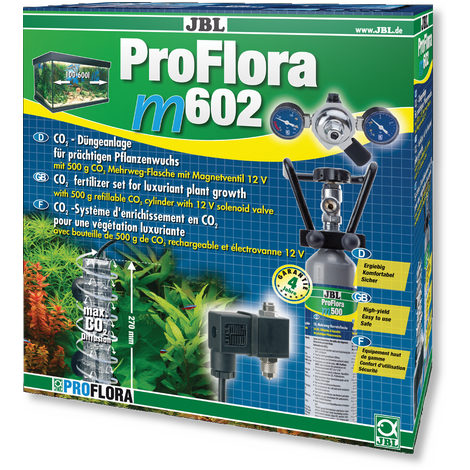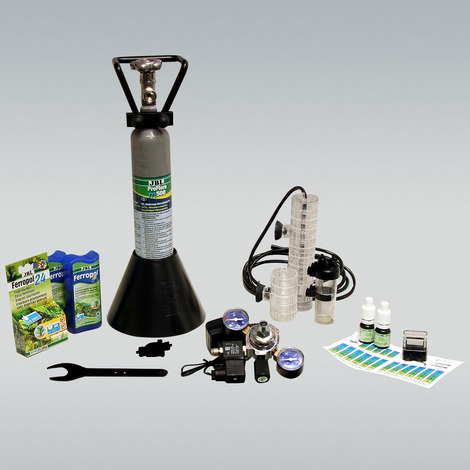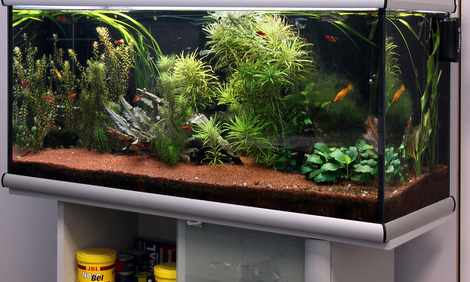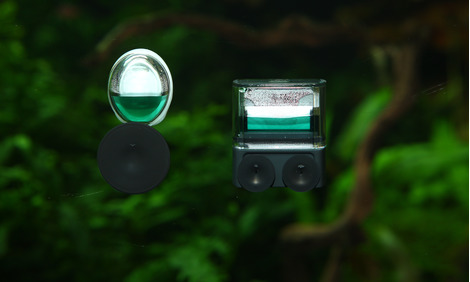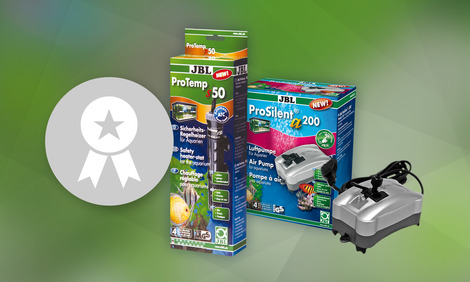Nutrition for aquarium plants
Plants provide the aquarium with vital oxygen for the aquarium dwellers, prevent algae growth, remove pollutants, provide hiding places and reduce pathogens. The JBL plant fertiliser system supplies the plants with the main nutrient CO2 through the water. They absorb this through their leaves.
Easy to install
The system comes completely ready for connection. Screw the pressure reducer onto the CO2 storage cylinder. Connect the pressure reducer with the hose to the diffuser in the aquarium. The CO2 enters the aquarium and is dissolved in the water by the diffuser. The CO2 supply can be interrupted at night by adding a solenoid valve (not included).
Safe
The storage cylinder is TÜV tested and is equipped with an overpressure relief. Thanks to the check valve no water can enter the cylinder. The enclosed stand prevents the cylinder from falling over. The capacity of a CO2 system depends on various factors. The carbonate hardness, the quantity and species of the plants and the strength of the water surface movement are decisive. A 500 g cylinder which is not switched off by a solenoid valve during the night lasts with its default adjustment for about 4 months.
JBL PROFLORA m602
Refillable plant fertiliser system complete kit for freshwater aquariums, with night switch-off
PROFLORA CO2 ADVANCED SET M
- CO2 fertiliser system for the best feeding of fast and slow growing plants in freshwater aquariums from 100 up to 600 l
- Easy use and efficient: refillable 500 g cylinder. Simple assembly, no separate water pump required. Can be converted into disposable system
- Professional water care with night switch-off: precise dosing due to pressure reducer. Even release. Effective distribution due to extendable diffuser. Best check: bubble counter, CO2/pH test. Residual pressure display on pressure gauge
- TÜV tested storage cylinder, pressure cylinder with overpressure relief. Stand ensures cylinder does not fall over. Hose screw connection prevents hose from slipping, check valve prevents water entering the cylinder
- Package contents: CO2 plant fertiliser system ProFlora m602, incl. refillable 500g CO2 cylinder, fitting, stand, pressure reducer, night switch-off (time switch sold separately), diffuser, bubble counter, 2 m hose, backflow stop, CO2/pH test
JBL PROFLORA m602
Properties
Electronic label / illuminant
| Mercury: | No |
| Dimmable: | No |
Technical Data
| capacity from - to: | 100-600 |
Owing to a production fault a green colour change may not occur with the batches 1000 and 1001, despite increased CO2 supply.
Should you have one of the above mentioned batches, you can request a new refill set free of charge upon presentation of the sales receipt and a photo of the batch number. Please contact our customer service under: https://www.jbl.de/support/
If water runs back into the bubble counter, that’s not a problem as long as the water is not drawn towards the night time shut-off from there. The excess water is normally pressed out of the system again during the day.
There is no general answer to this question, as we do not know what the desired number of bubbles for your aquarium is. One bubble contains approx. 0.125 mg CO2, which corresponds to 4 million bubbles for a 500 g cylinder. At a consumption of 10 bubbles per minute (600 bubbles per hour), this corresponds to 6667 hours, which in turn corresponds to around 277 days or slightly longer than 9 months of unchanged CO2 supply.
Please note that this is a rough estimate and does not represent a guarantee about how many days you can actually get out of one compressed gas cylinder.
The rapid drop in the cylinder pressure shortly before the end of the charge does not constitute grounds for complaint. It is normal and unavoidable from a technical standpoint.
Reason: The cylinder is filled approximately halfway with liquid carbon dioxide. You remove gaseous CO2 from the cylinder; the corresponding share of the liquid CO2 passes to the gaseous phase; the pressure remains constant. It isn’t until less CO2 passes from the liquid phase to the gaseous phase that the cylinder pressure begins to drop.
This means your system is functioning normally.
When the electromagnetic valve in the controller is switched off, the pressure in the entire system from the cylinder to the pressure reducer and the tubes and to the electromagnetic valve persists. When the valve is opened, the pressure in the system escapes first and then the system continues to operate as usual.
You can decrease / prevent this by reducing the operating pressure in your pressure reducer. In our new pressure reducers, this can be done with an Allen wrench under the black cover top.
Algae problems in an aquarium can never be traced to just one factor or general condition, and instead, are always the result of a combination of different factors, which include light, fertilization, water changes – specifically, how often and how much – feeding, fish population and, of course, the specific water parameters.
According to analyses that were performed over a course of a number of years, red algae, at least the common brush algae and beard algae, occur in descending order at the following parameters:
1) too little carbon dioxide (in relationship to 100 % of the measured tank); the pH level should be in the slightly acetic range, depending on the carbonate hardness, in every case.
2) elevated phosphate levels (over 90 %); phosphate limitation by means of JBL PhosEx ultra is often helpful here.
3) too little and too irregular fertilization (there should always be traces of iron at least).
4) insufficient water changes; a weekly water change of over 30 % is recommended for algae problems.
5) not enough fast-growing plants.
500 g of carbon dioxide are equivalent to 11.36 mol (1 mol of carbon dioxide weighs 44.01 g).
1 mol of an ideal gas occupies 22.4 l volume under normal conditions (normal air pressure and temperature), which means the following for 500 g of carbon dioxide:
11.36 x 22.4 l = 254.48 l.
A room of 20 m2 (4 m x 5 m) and a ceiling height of 2.5 m contains 50 m³ of air, which is 50,000 l.
Carbon dioxide is heavier than air and collects at the bottom under calm conditions. The gas would be 1.27 cm above the ground with 500 g of carbon dioxide.
Then, correspondingly, 4 times higher with 2 kg.
When the CO₂ is mixed with the air in the room, 254.48 l of carbon dioxide correspond to a concentration of 0.5 % of carbon dioxide with 50,000 l room volume of a room with a size of 20 m2 and a standard ceiling height, which is in the range of the maximum work place concentration for an 8-hour working day.
Accordingly, no excessive danger is associated with carbon dioxide compressed gas systems for aquariums.
Nevertheless, a few points should be observed when dealing with a compressed gas system:
1) Please be aware that the compressed gas cylinders must undergo a TÜV test regularly every 10 years.
2) Rusty cylinders, especially with rust near or on the bottom, should no longer be used, even if they have a valid TÜV mark.
3) Do not store the compressed gas cylinders in the sun, as this causes the internal pressure to rise. Normally, nothing will happen if you do, as the cylinders are constructed to withstand pressures up to 200 bar, but the bursting disk may burst, thereby causing all the gas to escape. In this case, do not touch the cylinder without hand protection, as the cylinder becomes very cold due to the drop in pressure.
The connections on reusable CO₂ systems are generally standardised so that they can be used with other cylinders, with the exception of a few cases.
However please note the following restrictions. Some larger-sized cylinders are not approved for non-stop operation with pressure reducers and you will lose your warranty claim if you use such systems.
The cylinder pressure of 50 – 60 bar, depending on the room temperature, remains constant until the cylinder is almost completely empty. The easiest method is to weigh your CO2 cylinder incl. bracket when it is completely empty. This way you will know the exact tare weight of your CO2 cylinder with its attachment parts at any time. If you forget it you can read the tare weight on the CO2 cylinder (stamp marking at the neck of the cylinder) and add 0.5 kg for the safety bracket. A full m500 CO2 cylinder with security bracket weighs according to that tare + 1 kg (0.5 kg bracket + 0.5 kg filling) – a m2000 tare + 2.5 kg (0.5 kg bracket + 2 kg filling).
Please check whether the check valve (JBL SafeStop) is installed properly. It should be installed as the last element before the reactor and with the tip of the arrow pointing to the reactor (JBL Taifun).
A general answer to this question cannot be given, as that would require additional information such as the number of bubbles per minute, whether you use a night time switch-off and how long the CO2 is supplied each day.
The storage life of a filling can be calculated approximately in a simplified manner. A CO2 bubble contains approx. 0.125 mg CO2, which is for 20 bubbles per minute of withdrawal for 24 hours 3.6 g of carbon dioxide per day or a range of slightly less than 139 days for the 500 g cylinder.
With a night time switch-off and 12 hours of CO2 supply, the range is slightly under 278 days for the same number of bubbles.
The calculation of range is analogous for the 2 kg compressed gas cylinder.
1. Increase the volume of water changed each week to about 30-50%.
2. Fertilise regularly after each water change, e.g. with JBL Ferropol.
3. If necessary add a daily dose of Ferropol 24.
4. If algae promoting nutrients (especially phosphate) are present in higher quantities, use e.g. JBL PhosEx ultra to keep them under control.
5. Most important is carbon dioxide. Beard and brush algae are always a sign that there is too little carbon dioxide in the water. If a CO2 system is in use, increase its dosage. Alternatively consider installing a CO2 system like JBL ProFlora u401 or m601.
6. Put in fast growing stem plants as nutrient competitors.
7. If there is strong current, reduce it slightly.
Please note two important points:
1) Cylinder: Reusable cylinders are TÜV tested and this is stamped on the cylinder. This test needs to be renewed every 10 years, with the bottom of the cylinder and the valve sealing and threaded joint being tested.
2) The carbon dioxide:
Depending on its concentration, carbon dioxide is harmful in the air.
The respiratory rate and pulse rate increase at a carbon dioxide concentration of 3-5%. Other symptoms are headaches, discomfort and ringing in the ears. Carbon dioxide concentrations of 8-10% and more cause these symptoms to become more pronounced. This may lead to cramps, fainting, apnoea and death from suffocation.
One 500 g cylinder contains 500 g CO2. This is equal to 11.36 mol (chemical substance amount unit). One mol of a gaseous substance has a volume of 22.414 l under normal conditions (273.15 K, 101325 Pa), so that 500 g of CO2 result in a volume of 254.7 l. CO2 is heavier than air, so that it collects on the ground. This corresponds to a CO2 height level in the range of 12.735 mm = 1.27 cm for a room of 20 m². If it is mixed completely with the air in a room of 20 m² and a height of 2.5 m (corresponds to 50,000 l), this corresponds to a maximum gas concentration of 0.5 volume %, which is well below the dangerous level.
During aeration and/or when there is a strong current, a gas equilibrium is achieved between the ambient air and the water. As a result a corresponding but very low CO2 content occurs too. BUT this low CO2 content is far too low to for most aquarium plants to thrive. The aquarium owner is therefore dependent on an additional CO2 supply by a CO2 fertiliser system. The higher CO2 content this achieves is reduced or, as commonly referred to in aquatics, expelled by the aeration and strong current. Therefore well planted aquariums should only be slightly aerated at night, if required.
